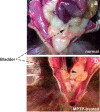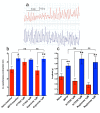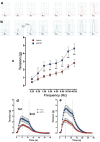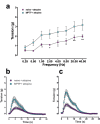Altered detrusor contractility in MPTP-treated common marmosets with bladder hyperreflexia
- PMID: 28520722
- PMCID: PMC5435136
- DOI: 10.1371/journal.pone.0175797
Altered detrusor contractility in MPTP-treated common marmosets with bladder hyperreflexia
Abstract
Bladder hyperreflexia is a common non-motor feature of Parkinson's disease. We now report on the contractility of the isolated primate detrusor strips devoid of nerve input and show that following MPTP, the amplitude and frequency of spontaneous contraction was increased. These responses were unaffected by dopamine D1 and D2 receptor agonists A77636 and ropinirole respectively. Contractions by exogenous carbachol, histamine or ATP were similar and no differences in the magnitude of noradrenaline-induced relaxation were seen in detrusor strip obtained from normal and MPTP-treated common marmosets (Callithrix jacchus). However, the neurogenic contractions following electrical field stimulation of the intrinsic nerves (EFS) were markedly greater in strips obtained from MPTP treated animals. EFS evoked non-cholinergic contractions following atropine were also greater but the contribution of the cholinergic innervation as a proportion of the overall contraction was smaller in the detrusor strips of MPTP treated animals, suggesting a preferential enhancement of the non-cholinergic transmission. Although dopaminergic mechanism has been proposed to underlie bladder hyperreflexia in MPTP-treated animals with intact bladder, the present data indicates that the increased neurogenically mediated contractions where no extrinsic innervation exists might be due to long-term adaptive changes locally as a result of the loss of the nigrostriatal output.
Conflict of interest statement
Figures









Similar articles
-
Changes in cholinergic and purinergic neurotransmission in pathologic bladder of chronic spinal rabbit.J Urol. 1996 Nov;156(5):1862-6. J Urol. 1996. PMID: 8863633
-
Nerve transfer for restoration of lower motor neuron-lesioned bladder function. Part 1: attenuation of purinergic bladder smooth muscle contractions.Am J Physiol Regul Integr Comp Physiol. 2021 Jun 1;320(6):R885-R896. doi: 10.1152/ajpregu.00299.2020. Epub 2021 Mar 24. Am J Physiol Regul Integr Comp Physiol. 2021. PMID: 33759578 Free PMC article.
-
Effect of cryoinjury on the contractile parameters of bladder strips: a model of impaired detrusor contractility.Brain Res Bull. 2002 Oct 15;59(1):23-8. doi: 10.1016/s0361-9230(02)00833-x. Brain Res Bull. 2002. PMID: 12372544
-
Berberine improves neurogenic contractile response of bladder detrusor muscle in streptozotocin-induced diabetic rats.J Ethnopharmacol. 2013 Dec 12;150(3):1128-36. doi: 10.1016/j.jep.2013.10.039. Epub 2013 Oct 30. J Ethnopharmacol. 2013. PMID: 24184080
-
Muscarinic receptor subtypes modulating smooth muscle contractility in the urinary bladder.Life Sci. 1999;64(6-7):419-28. doi: 10.1016/s0024-3205(98)00581-5. Life Sci. 1999. PMID: 10069505 Review.
Cited by
-
Therapeutic Approaches to Non-Motor Symptoms of Parkinson's Disease: A Current Update on Preclinical Evidence.Curr Neuropharmacol. 2023;21(3):560-577. doi: 10.2174/1570159X20666221005090126. Curr Neuropharmacol. 2023. PMID: 36200159 Free PMC article.
-
Tissue Engineering and Stem Cell Therapy in Neurogenic Bladder Dysfunction: Current and Future Perspectives.Medicina (Kaunas). 2023 Aug 3;59(8):1416. doi: 10.3390/medicina59081416. Medicina (Kaunas). 2023. PMID: 37629705 Free PMC article. Review.
-
Dysregulation of epithelial ion transport and neurochemical changes in the colon of a parkinsonian primate.NPJ Parkinsons Dis. 2021 Jan 21;7(1):9. doi: 10.1038/s41531-020-00150-x. NPJ Parkinsons Dis. 2021. PMID: 33479243 Free PMC article.
-
Molecular Mechanism Operating in Animal Models of Neurogenic Detrusor Overactivity: A Systematic Review Focusing on Bladder Dysfunction of Neurogenic Origin.Int J Mol Sci. 2023 Feb 7;24(4):3273. doi: 10.3390/ijms24043273. Int J Mol Sci. 2023. PMID: 36834694 Free PMC article.
-
Autonomic dysfunction in Parkinson disease and animal models.Clin Auton Res. 2019 Aug;29(4):397-414. doi: 10.1007/s10286-018-00584-7. Epub 2019 Jan 2. Clin Auton Res. 2019. PMID: 30604165 Free PMC article. Review.
References
-
- Fitzmaurice H, et al. Micturition disturbance in Parkinson's disease. Brit. J. Urol. 57, 652–656 (1985). - PubMed
-
- Chaudhuri KR, Healy DG. & Schapira A.H. National Institute for Clinical Excellence Non-motor symptoms of Parkinson's disease: diagnosis and management. Lancet. Neurol. 5, 235–245 (2006). doi: 10.1016/S1474-4422(06)70373-8 - DOI - PubMed
-
- Sakakibara R., et al., SPECT imaging of the dopamine transporter with [(123)I]-beta-CIT reveals marked decline of nigrostriatal dopaminergic function in Parkinson's disease with urinary dysfunction. J. Neurol. Sci. 187, 55–59 (2001). - PubMed
-
- Winge K., Friberg L., Werdelin L., Nielsen K.K. & Stimpel H. Relationship between nigrostriatal dopaminergic degeneration, urinary symptoms, and bladder control in Parkinson's disease. Eur. J. Neurol. 12, 842–850 (2005). doi: 10.1111/j.1468-1331.2005.01087.x - DOI - PubMed
-
- Seki S., Igawa Y., Kaidoh K., Ishizuka O., Nishizawa O. & Andersson K.E Role of dopamine D1 and D2 receptors in the micturition reflex in conscious rats. Neurol. Urodyn. 20, 105–113 (2001). - PubMed
MeSH terms
Substances
LinkOut - more resources
Full Text Sources
Other Literature Sources
Molecular Biology Databases

